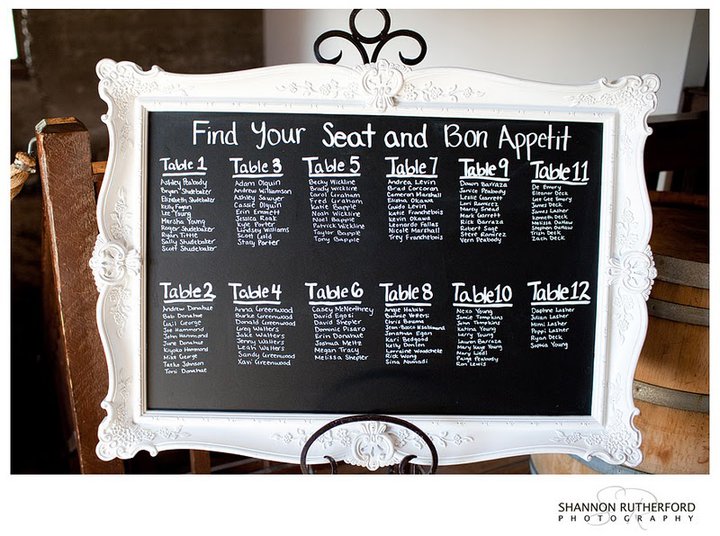by Saroyah
 Seating charts can be one of the most stressful parts of wedding planning. It doesn’t help that they typically have to be done towards the very end, or that they can’t be easily delegated. While dreaded, there’s no questioning their importance: they ease guests’ tensions and anxieties, can eliminate some intense drama and have the power to create a more enjoyable experience for everyone.
Seating charts can be one of the most stressful parts of wedding planning. It doesn’t help that they typically have to be done towards the very end, or that they can’t be easily delegated. While dreaded, there’s no questioning their importance: they ease guests’ tensions and anxieties, can eliminate some intense drama and have the power to create a more enjoyable experience for everyone.
Fortunately, there are some preparatory steps that you can take before your attendance list is complete that will ease later complications. With some decent tact and common sense, and years of expert experience behind us, here’s a list of helpful hints from the professionals on creating your perfect chart.
- Choose the method to your madness. Some wedding planners have a preferred software program, and if you’re using online invitations, they have their own program as well for tracking attendance. Whether you choose to be techy or old fashioned, using the classic board and sticky notes, obtain the floor plan in advance. Your wedding planner or the venue should have one easily handy.
- Start early. Once you have your floor plan and the RSVPs start coming in, you can begin artificially grouping guests. Simply adding a column next to your guests’ names for their relation, someone you want to seat them with, or a group name, will jump-start the process. The label can be something like “fiancé’s cousin” or “sorority sister.” This will make it easier to group your guests later on. I’ve found Excel to be extremely useful for this, as most software programs, which also have a way to add notes to your list of attendees, have ways to export your guest list to Excel.
- Use the food to dictate the seating. Are you having a multi-course menu or a buffet? Knowing this will help determine how you will seat your guests. If you are having a multi-course menu where guests have specifically signed up for a certain meal, you will need escort and place cards, and the seating has to be exact. While this is a bit more complicated, choosing seats for each guest makes it easier for guests and the catering staff and also shows your guests that you actually thought about them. How to keep stress at bay when placing people like chess pieces on a board? Wedding planners advise you to keep these words of wisdom in mind: Remember that people aren’t sitting the whole time. Especially with good music and good food, the conversation will flow. Cocktail hour also provides a great opportunity for guests to mingle, so don’t worry so much. People will be up and about, and they will have plenty of time to socialize with whomever they want.
- Manage the friends and family tables. Determine whether you want all-friends and all-family tables, or you want to mix it up. Either way, sort out the tensions and troublemakers first. Even if you decide to keep family and friends separate, the professionals (and surely your guests) would advise you to avoid the dreaded all-singles table, or a single at an all-couple’s table—sensitivity is key! If you have an odd-man out, the roommate that knows no one or the since-birth best friend, many planners suggest that you allow them to bring a plus-one to eliminate some of the awkwardness. Remember your experience at past weddings or the horror stories of others. If you do choose to be daring and blend the groups, do so with a grain of salt. While this can spur some of the best conversation, some comfort level can be maintained by keeping some pairs of friends together. People will most likely be more outgoing if they have at least one or two people who they know sitting with them.
- Whether you decide to mix or not, spread out the socialites and use your family wisely. If you know a handful of people who are masters of the art of conversation, it may prove best to spread out. Use them as the table’s glue; they can keep conversations flowing among mixed groups.
If you choose to have separate family tables, know that the parents of the bride and groom often sit opposite each other. Depending on the number of guests, however, you can have them head their own table, each consisting of their close friends and family. In the case of divorced parents or estranged family, they can each host their own table and keep them separate—make notes of this in advance. - Lastly. Ask family and close friends for help. Like with your wedding dress, you have the final say but it doesn’t hurt to ask for a second opinion. You may have forgotten your Aunt Tess and Cousin Mary haven’t spoken in years. Or that your friends broke up. Use your close circle as a resource.
Be patient. Remember it’s your day. Enjoy!




